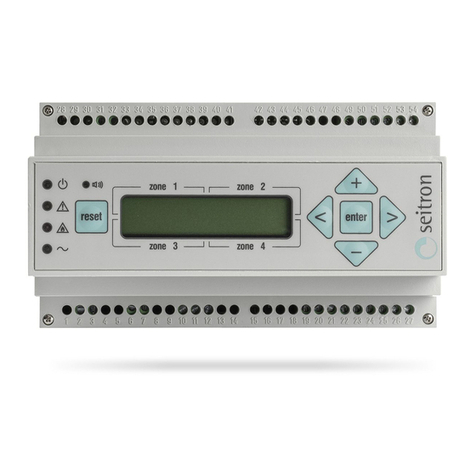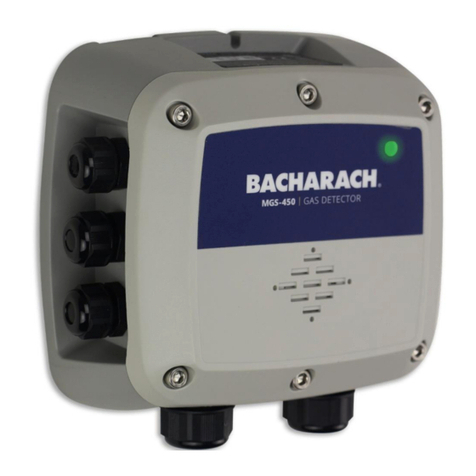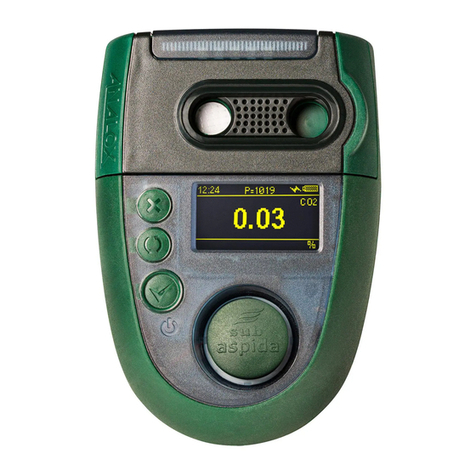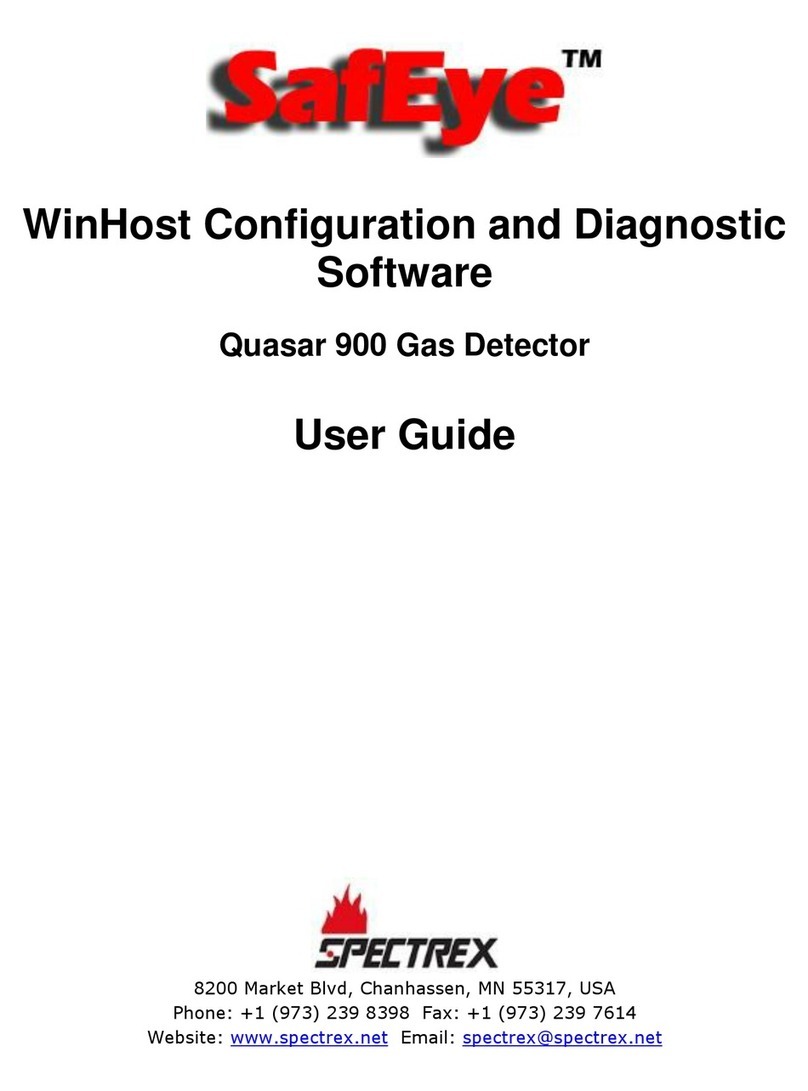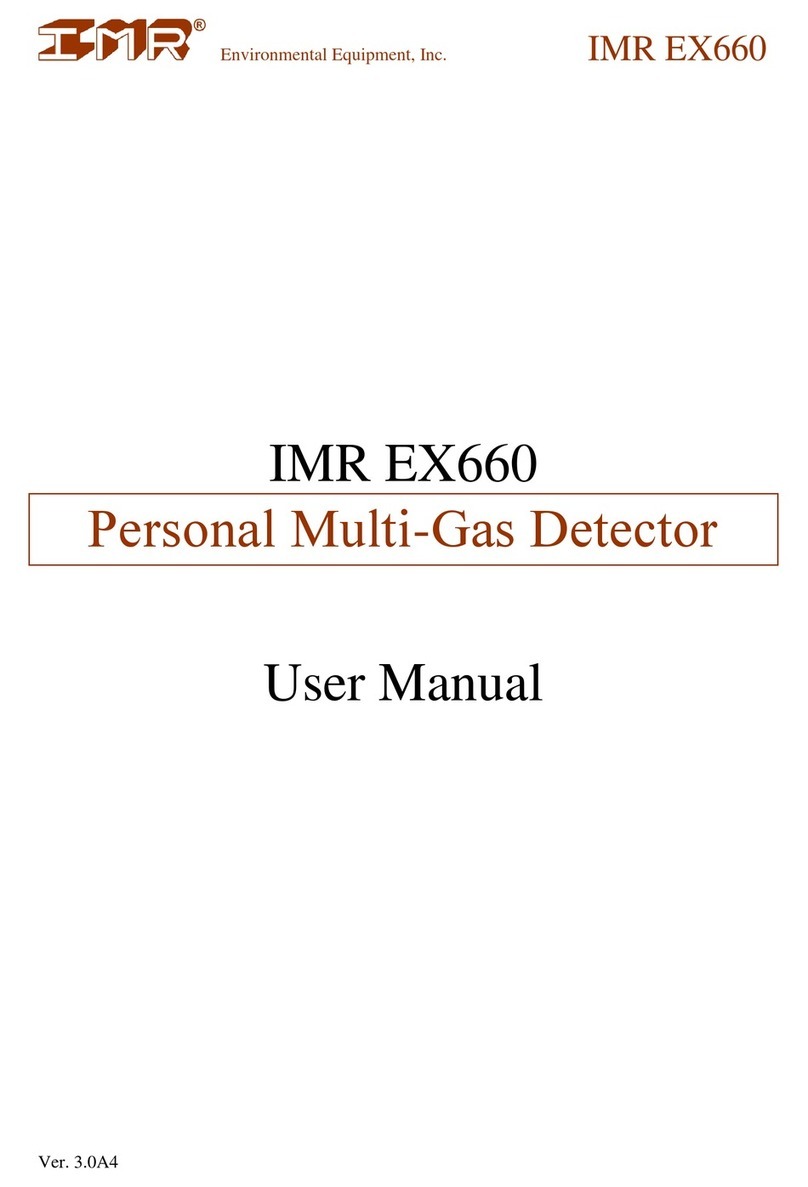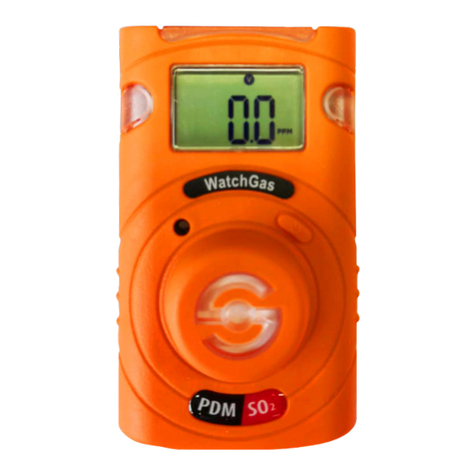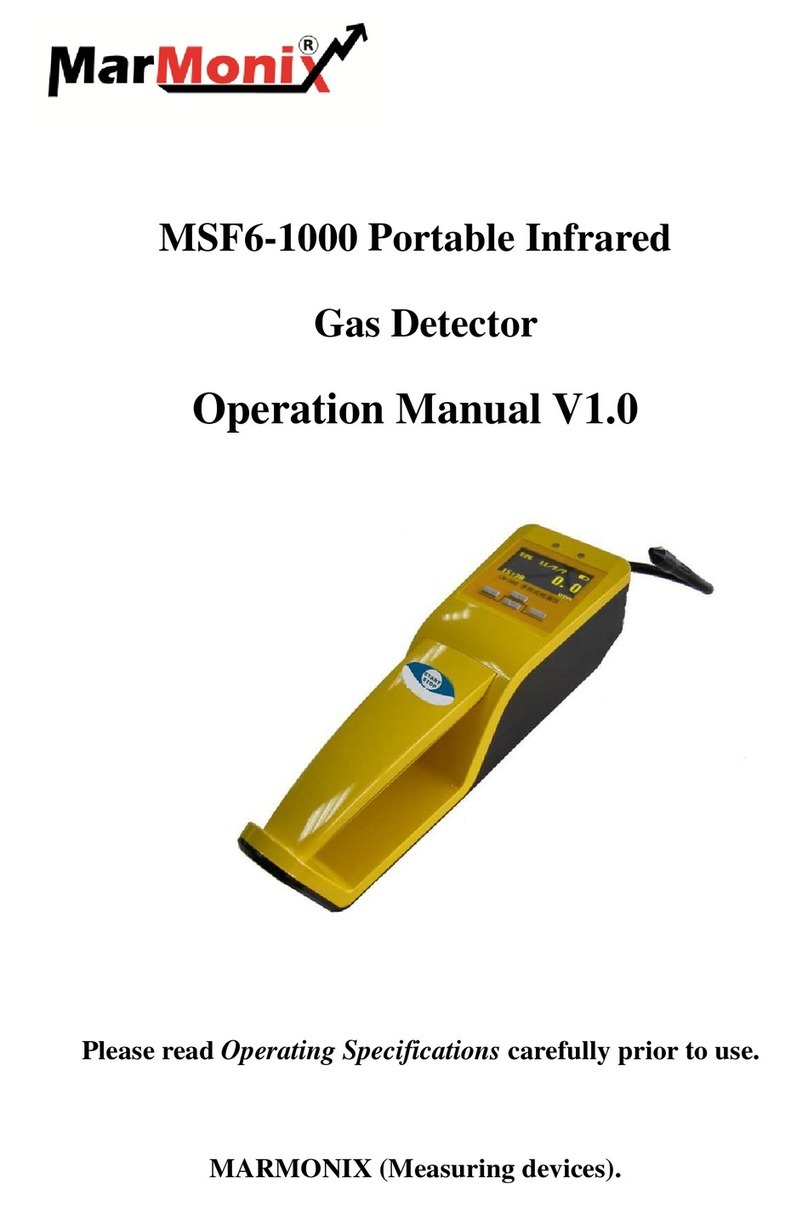Trolex Sentro 1 User manual

www.trolex.com
TX6351
•
TX6352
Sentro 1 Universal Gas Detector

TX6351 • TX6352 User Manual
P5536.1600 rev B 3
TX6351 • TX6352 Sentro 1 Universal Gas Detector
Contents
1. Product Overview 4
1.1 Operating Features 4
1.2 Application 5
1.3 Product Options 5
1.4 Dimensions 6
1.5 Technical Information 7
1.6 Electrical Details 9
1.7 Sentro eModules 11
2. Certification 18
3. Installation 23
3.1 Safety Precautions 20
3.2 Tools and Test
Equipment Required 24
3.3 Siting Recommendations 25
3.4 Connections 26
3.4.1 0.4 to 2 V Analogue
Output Signal 26
3.4.2 4 to 20 mA Analogue
Output Signal 27
3.4.3 5 to 15 Hz Output Signal 28
3.4.4 Contact Output Signal 28
3.4.5 RS485 Data Output Signal 29
3.5 Connecting in Hazardous
Areas 30
4. Setup and Calibration 31
4.1 Controls and Indicators 31
4.2 Main Display 33
4.3 Security Code Access 34
4.4 Main Menu 35
4.4.1 Calibrate 36
4.4.2 Sentro 1 Setup 39
4.4.3 Output Setup 41
4.4.4 Modbus 44
4.4.5 Module Setup 44
4.4.6 Support 47
5. Diagnostics and
Maintenance 48
5.1 Diagnostic Messages 48
5.2 Maintenance 49
5.3 Maintenance and
Calibration Log 52
5.4 Disposal 53
Disclaimers 53
Trademarks 54
Contact Details 54
Document History 54
www.trolex.com

TX6351 • TX6352 User Manual
4 P5536.1600 rev B
P5536.1600 rev B 5
1. Product Overview
TX6351
3/4 wire device with separate output signal and power lines.
Can be used with any Sentro eModule
TX6352
2-wire line powered 4 to 20 mA output signal.
Can ONLY be used with electrochemical Sentro eModules
1.1 Operating Features
• Fixed sensor for detection of Toxic Gases and Flammable Gases
•
Exclusive pre-calibrated plug-in gas sensing modules for many types of gas and
climatic conditions
• LCD readout and visual LED alarm indicators
• Choice of supply voltage and output signal format
• Heavy duty housing to IP65, EMC compliant
• STEL and TWA monitoring for selected gases
1.2 Application
Fixed point gas detection for safety monitoring in hazardous areas and general purpose
applications.
Underground Mining and Tunnelling
Ex ia I Ma
TX6351.01i
TX6352.01i
Supply Voltage:
12 V dc from an
approved power source
Type of protection:
Intrinsically safe. Ex ia
Category:
I M1
General Purpose
TX6351.03
TX6352.03
Supply Voltage:
24 V dc
1.3 Product Options
4-wire connection
Mining Ex ia
General Purpose
0.4 to 2 V output
TX6351.01i.11
-
4 to 20 mA output
TX6351.01i.12
TX6351.03.12
5 to 15 Hz output
TX6351.01i.13
-
Contact output
TX6351.01i.14
TX6351.03.14
RS485 output
TX6351.01i.15
TX6351.03.15
*2-wire line powered
Mining Ex ia
General Purpose
4 to 20 mA output
TX6352.01i.12
TX6352.03.12
*For use with Toxic Gas Sentro eModules only
www.trolex.com www.trolex.com

TX6351 • TX6352 User Manual
6 P5536.1600 rev B
P5536.1600 rev B 7
1.5 Technical Information
Ambient temperature limits
-20 to +40°C
Storage temperature
-20 to +60°C
Ambient pressure
800 to 1100 mbar
Humidity
15% to 90% non-condensing
Protection classification
Dust and waterproof to IP65. Gas Port: IP54.
Housing material
Reinforced polymer
Nett weight
530 g
Cable entries
2 x M20
Electrical connections
4 mm barrier/clamp terminals
Conductors
A maximum of two per terminal
Conductor size
A maximum of 2.5 mm²
Terminal torque
2.4 Nm maximum
Information display
128 x 64 dot graphic backlit LCD
Vibration limits
Vibration limits (IEC 60079-29-1):
•
10 to 30 Hz - 1.00 mm total excursion
•
31 to 150 Hz - 19.6 m/s
2
acceleration peak
Impact limits
20 joules (housing)
Calibration and setup
Digitally controlled ZERO and SPAN pushbutton
setting
Signal fix
The analogue output signal of the sensor is fixed
during calibration to prevent false alarms from
being initiated
Fault indication
Under range signal transmitted and fault display for:
•
Loss of communications from the sensing
module
•
Sensing module absent for more than 10
seconds
•
Sensor over-range protect
Key coding
Coding stops prevent insertion of a non-valid
sensing module.
1.4 Dimensions
www.trolex.com www.trolex.com

TX6351 • TX6352 User Manual
8 P5536.1600 rev B
P5536.1600 rev B 9
Alarms
Programmable GENERAL alarms and HIGH alarms
with an LED indicator.
The two adjustable alarm setpoints are preset
during manufacture to default values appropriate
to the type of sensor, determined by the sensing
module being used.
STEL and TWA
Automatic setting of STEL and TWA limits to EH40
standards.
STEL: Exposure over 15-minute successive periods
TWA: Exposure over a continuous rolling 8-hour
period
Output signals
0.4 to 2 V
4 to 20 mA
5 to 15 Hz
Dual contacts
RS485 Modbus datacomms
1.6 Electrical Details
General Purpose
TX6351
3/4 wire. Remote powered
4 to 20 mA analogue output
Supply voltage:
18 to 28 V
Max. line load:
500 R at 24 V
Type of sensor:
Toxic
Flammable
Infrared
Supply current:
40 mA
40 mA
60 mA
TX6351
3/4 wire. Remote powered
Dual output contacts
Supply voltage:
20 to 28 V
Type of sensor:
Toxic
Flammable
Infrared
Supply current:
35 mA
45 mA
60 mA
TX6351
3/4 wire. Remote powered
RS485 datacomms output
Supply voltage:
14 to 28 V
Line:
Modbus protocol
Type of sensor:
Toxic
Flammable
Infrared
Supply current:
40 mA
40 mA
60 mA
TX6352
2 wire. Line powered
4 to 20 mA analogue output
Supply voltage:
18 to 28 V
Max. Line Load:
300 R
Type of Sensor:
Toxic only
www.trolex.com www.trolex.com

TX6351 • TX6352 User Manual
10 P5536.1600 rev B
P5536.1600 rev B 11
Mining and Tunnelling
TX6351
3/4 wire. Remote powered
4 to 20 mA
Supply voltage:
10 to 14 V
Max. line load:
220 R maximum @ 12 V dc
Type of sensor:
Toxic
Flammable
Infrared
Supply current @ 12 V:
48 mA
70 mA
91 mA
TX6351
3/4 wire. Remote powered
Dual output contacts
Supply voltage:
10 to 14 V
Type of sensor:
Toxic
Flammable
Infrared
Supply current @ 12 V:
60 mA
85 mA
105 mA
TX6351
3/4 wire. Remote powered
RS485 datacomms output
Supply voltage:
10 to 14 V
Line:
Modbus protocol
Type of sensor:
Toxic
Flammable
Infrared
Supply current @ 12 V:
25 mA
60 mA
80 mA
TX6351
3/4 wire. Remote powered
0.4 to 2 V analogue output
Supply voltage:
10 to 14 V
Min. line load:
10 KR
Type of sensor:
Toxic
Flammable
Infrared
Supply current @ 12 V:
20 mA
60 mA
80 mA
TX6351
3/4 wire. Remote powered
5 to 15 Hz analogue output
Supply voltage:
10 to 14 V
Max. line load:
Opto isolated to 2 mA maximum
Type of sensor:
Toxic
Flammable
Infrared
Supply current @ 12 V:
20 mA
60 mA
80 mA
TX6352
2 wire. Remote powered
4 to 20 mA analogue output
Supply voltage:
10 to 14 V
Max. line load:
90 R
Type of sensor:
Toxic only
1.7 Sentro eModules
Plug-in pre-calibrated modules with standardised output data.
•
Each module stores all the necessary data about its type identification, sensing
range and specific calibration. This data is automatically recognised by Sentro when
the module is loaded into the module bay.
•
The modules are pre-calibrated so can be substituted at any time by a replacement
module – usually of the same type, but an alternative may be inserted if required.
•
Insert coding stops to prevent invalid module combinations.
•
The sensing module will identify itself when plugged into the sensor housing and
auto configuration will take place.
•
All Sentro Modules have two output alarm signals for GENERAL alarm and HIGH
alarm. Default values are entered during manufacture and these can be changed to
preferred values.
•
The alarm signals can be set to illuminate built-in flashing LED indicators.
•
The signals can operate the two GENERAL alarm and HIGH alarm relays on the
CONTACT OUTPUT version of Sentro 1.
Gas Sensor
www.trolex.com www.trolex.com

TX6351 • TX6352 User Manual
12 P5536.1600 rev B
P5536.1600 rev B 13
Flammable gases • Poison resistant catalytic sensor
The sensor can be configured to respond to many flammable
gases and vapours. It is usual to calibrate to methane in
terms of %LEL or %volume.
TX6350
.240
.246
.244
Methane CH
4
Methane CH
4
Methane CH
4
Sensing element
Poison resistant pellistor with active temperature compensation
Sensing range
0 to 100% LEL
based on 4.4%v/v
0 to 4% v/v
0 to 5% v/v
Linearity
Linear up to 3% v/v
3% to 5% ±0.25%
Max. Drift @ 25°C
±0.25% CH4 v/v per month
*Response time t(63)
<15 secs
*Response time t(90)
<20 secs
Sensing element life
>5 years in clean atmosphere
Warm up time
<5 mins in air or 1% v/v CH4
Stabilisation time
≥15 mins
GENERAL alarm
10% LEL (.240)
0.40% (.246)
0.50% (.244)
HIGH alarm
25% LEL (.240)
1.00% (.246)
1.25% (.244)
* Response times are tested by owing test gas using the calibration kit referred to in section 5.2
Maintenance.
Checkpoint
Not suitable for use with the TX6352 4 to 20 mA two wire, line powered version of
Sentro.
Checkpoint
The pellistor is automatically protected against exposure to excessively high
concentrations of gas.
Section 4.4.5
Toxic gases • Electrochemical cells
Selected toxic gas modules are equipped with automatic
STEL/TWA calculation in accordance with EH40.
TX6350
.250.50
.250.250
.250.300
.250.500
.251
.252
Carbon
Monoxide
CO
Carbon
Monoxide
CO
Carbon
Monoxide
CO
Carbon
Monoxide
CO
Hydrogen
Sulphide
H
2
S
Sulphur
Dioxide
SO
2
Sensing
element
Electrochemical cell
Sensing range
0 to
50 ppm
0 to
250 ppm
0 to
300 ppm
0 to
500 ppm
0 to
50 ppm
0 to
20 ppm
Linearity
±2% FS
Drift
2% per month
Repeatability
±2%
*Response
time t(63)
<20 secs
<30 secs
<20 secs
*Response
time t(90)
<30 secs
<45 secs
<30 secs
Operating life
2 years
Relative
humidity
15 to 90% non-condensing
Operating
temperature
-10 to +40°C
GENERAL
alarm
18 ppm
38 ppm
45 ppm
75 ppm
8 ppm
3 ppm
HIGH alarm
15 ppm
75ppm
90 ppm
150 ppm
15 ppm
6 ppm
STEL & TWA
200 ppm
200 ppm
200 ppm
200 ppm
10 ppm
1 ppm
30 ppm
30 ppm
30 ppm
30 ppm
5 ppm
0.5 ppm
* Response times are tested by owing test gas using the calibration kit referred to in section 5.2
Maintenance.
Section 4.4.5
www.trolex.com www.trolex.com

TX6351 • TX6352 User Manual
14 P5536.1600 rev B
P5536.1600 rev B 15
Toxic gases • Electrochemical cells - continued
Selected toxic gas modules are equipped with automatic
STEL/TWA calculation in accordance with EH40.
TX6350
.254
.254.10
.257
.259
.261
Nitrogen
Dioxide
NO
2
Nitrogen
Dioxide
NO
2
Oxygen
O
2
Nitric Oxide
NO
Hydrogen H
2
Sensing element
Electrochemical Cell
Sensing range
0 to 20 ppm
0 to 10
ppm
0 to 25%
0 to 50 ppm
0 to
1000 ppm
Linearity
±2% FS
±0.3% vol
±5% FS
±2% FS
Drift
2% per month
10%
per year
2% per month
Repeatability
±2%
*Response time
t(63)
<20 secs
N/A
<20 secs
<30 secs
*Response time
t(90)
<30 secs
<60 secs
<30 secs
<40 secs
Operating life
2 years
2 years
2 years
Relative humidity
15 to 90% non-condensing
Operating
temperature
-10 to +40°C
GENERAL
alarm
3 ppm
1.5 ppm
19%
(under)
8 ppm
150 ppm
HIGH alarm
6 ppm
3 ppm
23%
(over)
15 ppm
300 ppm
STEL & TWA
1 ppm
1 ppm
N/A
10 ppm
N/A
0.5 ppm
0.5 ppm
N/A
25 ppm
N/A
* Response times are tested by owing test gas using the calibration kit referred to in section 5.2
Maintenance.
Checkpoint
Toxic gas Sentro eModules have a very low power consumption, enabling 4 to 20 mA two wire
TX6352 line-powered version of Sentro to be used.
Checkpoint
All values listed are nominal and slight variations may occur depending upon operating
conditions.
•
The natural level of oxygen available in the atmosphere is influenced by relative humidity
and temperature. The oxygen sensor will react to these changes.
•
Sudden changes in atmospheric pressure will also cause temporary instability in
electrochemical sensors which may exceed 60 seconds.
•
Long periods of use in extremely high or low humidity may aect the response of the
sensor and shorten the life of electrochemical sensors.
•
Nitric oxide sensors must be continuously powered to maintain calibration stability. If
power has been absent for more than 10 minutes, it may take 24-48 hours for the sensor
to restore stability. Do not calibrate until the output signal is steady.
•
The presence of high levels of carbon dioxide (over 5%) may have a minor eect on the
accuracy of the oxygen sensor.
Checkpoint
Periodic calibration of the gas sensor should be carried out whilst it is in service. For oxygen
and carbon monoxide gas sensors Trolex recommends that this is carried out every 3
weeks. For other gas sensors Trolex recommends that this is carried out in accordance
with best practice for the industry where the gas sensor is being used, and should take into
consideration local operating conditions.
Section 4.4.5
www.trolex.com www.trolex.com

TX6351 • TX6352 User Manual
16 P5536.1600 rev B
P5536.1600 rev B 17
Checkpoint - Carbon Dioxide Sensors
Normal atmosphere contains carbon dioxide which will aect the sensor signal so
nitrogen gas must be used to accurately calibrate the zero value. Power should be
applied to the sensor and the nitrogen applied for at least 5 minutes to ensure that the
sensor has stabilised.
Checkpoint
Not suitable for use with the TX6352 4 to 20 mA two wire, line powered version of
Sentro 1.
Carbon Dioxide/Methane Gases • Infrared sensor
The sensor is highly specic to the selected gas and exhibits
consistent sensing accuracy with superior long-term stability.
The linear response means that it can be calibrated for low gas
concentrations and high concentrations up to 100% by volume.
TX6350
.243
.245
.242
.278.2
.278
.279
Methane
CH
4
Methane
CH
4
Methane
CH
4
Carbon
Dioxide
CO
2
Carbon
Dioxide
CO
2
Carbon
Dioxide
CO
2
Sensing element
Infrared
Sensing range
0 to
5% v/v
0 to
100% LEL
0 to
100% v/v
0 to
2% v/v
0 to
5% v/v
0 to
100% v/v
Zero drift
±0.05% v/v
per month
±1% LEL
per month
±0.5% v/v
per month
±0.05% v/v per month
±1% v/v
per month
Repeatability
±0.1% v/v
±2% LEL
±2% v/v
±0.05% v/v
±2% v/v
*Response time
t(63)
<15 secs
*Response time
t(90)
<30 secs
Operating life
<5 years
Relative humidity
15 to 90% non-condensing
Operating
temperature
-10 to +40°C
GENERAL
alarm
0.5% v/v
10% LEL
10% v/v
0.3% v/v
0.75% v/v
15% v/v
HIGH alarm
1.25% v/v
25% LEL
25% v/v
0.6% v/v
1.5% v/v
30% v/v
* Response times are tested by owing test gas using the calibration kit referred to in section 5.2
Maintenance.
www.trolex.com www.trolex.com

TX6351 • TX6352 User Manual
18 P5536.1600 rev B
P5536.1600 rev B 19
2. Certication
2.1 Europe (ATEX)
Ex certified for use in M1 applications:
Europe (ATEX):
TX6351.01i.xx/TX6352.01i.xx
Ex Certificate number: SIRA09ATEX2352X
Ex Certification code: I M1 Ex ia I Ma (20°C ≤ Ta ≤ +40°C)
Important
– Prior to installation, it is essential that the user refers to
Important – Prior to installation, it is essential that the user refers toImportant
the relevant certificate to ensure that the termination and cable
parameters are fully complied with and are compatible with
the application. Copies of certificates are available from
www.trolex.com.
ATEX directive 94/9/EC
EMC directive 2004/108/EC
Special Conditions for Safe Use
The minimum ingress protection stated in the Ex-certificates for the Sentro eModules
are satisfied when mounted in the Sentro Gas Detector, as are the conditions for impact
protection and external fuse protection in the case of the infrared eModule.
The Ex-certificates associated with the Sentro Modules are listed below:
eModule Flammable Group I SIRA 10ATEX2046U
eModule Toxic Group I SIRA 08ATEX2097U
eModule Infrared Group I SIRA 10ATEX2356U
2.2 Russia (Customs Union)
Ex Certificate number: TC RU C-GB.
ГБ
05.B.00616
Ex Certification code: PO Ex ia I Ma X
Conditions of Use
Prior to installation, it is essential that user refers to the above certificate for any specific
conditions of use. The user must ensure that the termination and cable parameters are
fully complied with and are compatible with the application. Copies of certificates are
available from Trolex.
2.3 South Africa (MASC)
Ex Certificate number: MASC M/11-419X
Ex Certification code: Ex ia I Ma
General Conditions for Safe Use
Prior to installation, it is essential that user refers to the above certificate to ensure that
the termination and cable parameters are fully complied with and are compatible with
the application. Copies of certificates are available from Trolex.
2.4 India (CIMFR)
Test report number: CIMFR/TC/P/H738
www.trolex.com www.trolex.com

TX6351 • TX6352 User Manual
20 P5536.1600 rev B
P5536.1600 rev B 21
2.5 Australia (IECEx)
Ex certified for use in Ma applications:
Australia (IECEx):
TX6351.01i.xx/TX6352.01i.xx
Ex Certificate number: IECEx ITA 14.0006X
Ex Certification code: Ex ia I Ma
Conditions of Safe Use
The following safety parameters are applicable to the Sentro 1 Sensor/Transmitters:
Model
Terminals
Input Parameters
Ui
li
Ci
Li
Pi
TX6351.01i.11
and
TX9081.01i.11
5 WRT 6
14.4 V
* 1
* 2
* 3
-
1 WRT (2 or 3)
-
-
-
-
-
TX6351.01i.12
and
TX9081.01i.12
5 WRT 6
14.4 V
* 1
* 2
* 3
-
1 WRT (2 or 3)
-
-
-
-
-
TX6351.01i.15
and
TX9081.01i.15
5 WRT 6
14.4 V
* 1
* 2
* 3
-
1 WRT 2
2 WRT 3
-
-
-
-
-
TX6351.01i.14
and
TX9081.01i.14
5 WRT 6
14.4 V
* 1
* 2
* 3
-
1 WRT 2
30 V
* 1
0
0
-
3 WRT 4
30 V
* 1
0
0
-
TX6351.01i.13
and
TC9081.01i.13
5 WRT 6
14.4 V
* 1
* 2
* 3
-
1 WRT 2
16.5 V
-
0
0
2.5 W
TX6352.01i.12
1 WRT 2
14.4 V
* 1
* 2
* 3
-
Model
Terminals
Output Parameters
Uo
lo
Po
Co
Lo * 5
TX6351.01i.11
and
TX9081.01i.11
5 WRT 6
-
-
-
-
-
1 WRT (2 or 3)
14.4 V
40 mA
135 mW
* 4
292 mH
TX6351.01i.12
and
TX9081.01i.12
5 WRT 6
-
-
-
-
-
1 WRT (2 or 3)
14.4 V
477 mA
1.72 W
* 4
2.1 mH
TX6351.01i.15
and
TX9081.01i.15
5 WRT 6
-
-
-
-
-
1 WRT 2
2 WRT 3
5.88 V
66 mA
97 mW
* 4
26 mH
TX6351.01i.14
and
TX9081.01i.14
5 WRT 6
-
-
-
-
-
1 WRT 2
0
0
0
0
0
3 WRT 4
0
0
0
0
0
TX6351.01i.13
and
TC9081.01i.13
5 WRT 6
-
-
-
-
-
1 WRT 2
0
0
0
0
0
TX6352.01i.12
1 WRT 2
-
-
-
0
0
* 1 Ii Not critical
* 2 Ci Ci = 0, unless an rModule is connected to the Sentro 1, then
Ci = 0.38 μF plus the Ci of the external sensors connected to the
rModule
* 3 Li Total Li of all external sensors and equipment connected to the rModule
* 4 Co 1 μF, unless the conditions stated in 60079-11 2011, Clause 10.1.5.2
part b can be satisfied
WRT With Respect To
General Conditions for Safe Use
Prior to installation, it is essential that user refers to the above certificate to ensure that
the termination and cable parameters are fully complied with and are compatible with
the application. Copies of certificates are available from Trolex Ltd.
www.trolex.com www.trolex.com

TX6351 • TX6352 User Manual
22 P5536.1600 rev B
P5536.1600 rev B 23
3. Installation
3.1 Safety Precautions
It is recommended that users refer to EN / IEC 60079-29-2 for guidance on the selection,
installation, use and maintenance of detectors for flammable gases and oxygen, when
installed in hazardous areas.
Hazardous areas
Do not disassemble the sensor whilst in the hazardous area or use a sensor that has
a damaged housing in the hazardous area. Irrespective of the gas being monitored,
the equipment must not be installed where there is possibility of an oxygen enriched
atmosphere.
Evacuation
If a dangerous level of gas concentration is detected by the instrument, leave the area
immediately.
Operating Life of Gas Sensors
Electrochemical cells contain an electrolyte that is gradually consumed during use. The
average life is about two years, dependant upon the duty cycle. The response should
be checked at regular intervals.
Sensitivity
Electrochemical cells for toxic gases can be aected by other interfering gases
which may displace the subject gas being monitored. Steam laden atmospheres and
condensation can also reduce the sensitivity.
Flammable
Be aware that some toxic gases are also ‘flammable’ at high percentage concentrations.
Operating Limits of Catalytic Combustion Sensors
Catalytic combustion sensors positively detect the presence of flammable gas. They
rely upon the presence of oxygen in the atmosphere and should only be used for gas
concentration up to the Lower Explosive Limit (LEL).
After this point, the output becomes non-linear and may erroneously indicate that the
gas concentration is below the LEL. They should not be used in oxygen enriched or
deficient atmospheres.
New South Wales Design Registration
If the equipment label contains an MDR number and is fitted with an eModule marked
with the same 6-digit number following “MDR”, the equipment is design registered. This
indicates that the equipment is in conformance with the following performance standard
as appropriate, and as modified by NSW Government regulations.
•
Methane detection: IEC 60079-29-1
•
Toxic gas or Oxygen detection: AS/NZS 4641
www.trolex.com www.trolex.com

TX6351 • TX6352 User Manual
24 P5536.1600 rev B
P5536.1600 rev B 25
Discrimination
Catalytic combustion sensors can detect a wide range of flammable gases but they
cannot discriminate between individual gases. They will respond to most, or all, of the
flammable components present in the atmosphere without distinguishing between them.
The table below shows the response variation of the catalytic combustion sensor on
exposure to a range of gases and vapours at the same %LEL concentration.
The figures are experimentally derived and expressed relative to the methane signal (=100).
Infrared sensors are highly specific to the defined gas type and may not respond to
other similar gases.
Contamination
The response of catalytic combustion gas sensors can be aected by air borne
contaminants which will reduce the sensitivity. Substances such as silicones, tetraethyl
lead, sulphur compounds and phosphate esters can cause permanent degradation
(poisoning). Halogenated hydrocarbons may also cause temporary inhibition.
Interference
If the atmosphere to be monitored contains a gas that dilutes or displaces the air, this
may reduce the response of catalytic sensors. Similarly, steam laden atmospheres and
condensation can reduce the stability.
High Concentrations of Flammable Gas
Exposure of low concentration catalytic combustion sensors to concentrations of
flammable gas greater than the LEL can aect the sensitivity and zero stability of
catalytic elements and the calibration should be checked after such an exposure.
Toxicity
Be aware that most flammable gases and vapours are also toxic at low concentrations of
LEL.
3.2. Tools and Test Equipment Required
No special tools are needed.
3.3. Siting Recommendations
Location of Gas Detectors
Each installation needs to be considered in its own right, with reference to safety
authorities and in compliance with mandatory local safety regulations. The sensor must
be operated in accordance with the User Manual to maintain safety, reliability and to
preserve safety integrity where applicable.
It is important that sensors are located in positions determined in consultation with those
who have specialised knowledge of the plant or installation and of the principles of gas
dispersion. Reference should also be made to those responsible for the engineering
layout and topology of the plant as they will be most familiar with the nature of the
potential dangers and the most likely sources of gas release.
It is also important to recognise that the characteristics of the gas source can be
influenced by many factors; including the relative density or buoyancy of the gas, the
pressure at the point of release, the ambient temperature and the ventilation of the site.
Sensor coverage cannot be simply expressed in terms of ‘number per unit area’.
Sensors need to be sited where they are capable of monitoring those parts of a plant
where gas may accumulate or where a source of gas release is expected to occur. This
way, the earliest possible warning of a gas release can be given to initiate shutdown
functions, alarm functions or safe evacuation of the premises.
Sensor Management
A very important part of an ecient gas monitoring system is the training of plant
personnel in operation and maintenance of the sensors and the complete monitoring
system. Training can be provided by qualified Trolex application engineers.
Once a sensor installation is complete, the sensor locations and types should be formally
recorded and a planned test and maintenance procedure instituted.
STEL and TWA
Specific gas sensors are equipped to automatically set STEL and TWA limits in
accordance with EH40 standards. Only gases with a listed EH40 STEL or TWA value
have this function enabled by default.
If the function is enabled for use, ensure that all accumulated data is reset to zero before
the commencement of a working period.
Gas/Vapour
Relative sensitivity
Gas/Vapour
Relative sensitivity
Methane
100
Carbon Monoxide
130
Propane
70
Hydrogen
120
n-Butane
70
Ammonia
155
n-Pentane
60
Cyclohexane
55
n-Hexane
60
Ethylene
90
Acetylene
85
www.trolex.com www.trolex.com

TX6351 • TX6352 User Manual
26 P5536.1600 rev B
P5536.1600 rev B 27
3.4 Connections
3.4.1 0.4 to 2 V Analogue Output
Signal
A low impedance two-wire voltage output
signal requiring a separate power supply to the
sensor.
12 V dc power can usually be derived from the
monitoring instrument being used.
The connection configuration works well up to
5-100 m distance between the sensor and the
monitoring equipment, dependent on cabling
and sensor current consumption.
Both the signal and the power supply to the
sensor are being carried in the common 0 V
conductor so at some point – influenced by
the length of the cable and the resistance of
the cable cores – the current flowing in the 0 V
conductor will impose an unacceptable voltage
error onto the signal.
This eect can be reduced on long distance
connections by increasing the size of the cable
cores, or even better, by running a separate
0 V conductor to power the sensor enabling
operating distances up to 1,000 m.
Alternatively, the sensor may be powered by a
suitable power source close by.
3.4.2 4 to 20 mA Analogue Output
Signal
TX6351
The output signal from terminals 1 and 2 is
a conventional 4 to 20 mA two wire current
regulated signal loop.
TX6352 (Toxic Sentro eModules only)
The output signal from terminals 1 and 2 is
a conventional 4 to 20 mA two wire current
regulated signal loop.
Electrochemical cells have very low power
consumption so the same loop can be used
to also power the sensor. No separate power
supply is needed.
Checkpoint
The TX6352 version of Sentro is
NOT
suitable for flammable gas and infrared
Sentro eModules.
www.trolex.com www.trolex.com

TX6351 • TX6352 User Manual
28 P5536.1600 rev B
P5536.1600 rev B 29
3.4.3 5 to 15 Hz Output Signal
A square wave, frequency variable output that
is proportional to the measured value.
A pull up resistor may be required at the
monitoring device.
3.4.4 Contact Output Signal
Dual independent output contacts for remote
signalling and control. Setpoint values for
GENERAL alarm and HIGH alarm are setup
during manufacture to prescribed levels
appropriate to the type of gas intended to be
monitored; determined by the gas sensing
module.
The setpoints may be adjusted to preference.
Checkpoint
The relay contacts are clearance compatible
for use with other intrinsically safe circuits
emanating from dierent IS power sources.
Section 4.4.3
3.4.5 RS485 Data Output Signal
RS485 serial data output with analogue signal
intelligence.
Use in conjunction with a PC for data display
and setpoint alarm warnings.
Up to 32 sensors acting as slaves can
communicate with the master unit on a single
data cable.
The address code of the sensor is marked on
the duty label of the sensor.
Physical layer:
RS485
Protocol:
Trolex proprietary
Connection mode:
Modbus
Number of points:
32
Maximum distance:
1,000 m
Recommended cable (specified in BS5308 Part
1) for locally powered sensors:
• 1 twisted pair
• 0.5 mm
2
• Overall screen
Recommended cable for sensors that are
powered through the data cable:
• 2 twisted pair
• 0.5 mm
2
• Individual/overall screen
www.trolex.com www.trolex.com

TX6351 • TX6352 User Manual
30 P5536.1600 rev B
P5536.1600 rev B 31
3.5 Connecting in Hazardous
Areas
Certified Intrinsically Safe for use in mining
hazardous areas, category M1, when used
with approved monitoring apparatus.
Power for the sensor must be derived from an
approved 12 V dc power supply e.g. TX6642
Intrinsically Safe Power Supply or approved
apparatus.
The installation must be in accordance with
the Sentro certification parameters.
Intrinsically
Safe
Apparatus
Hazardous Area
4. Setup and Calibration
4.1 Controls and Indicators
www.trolex.com www.trolex.com

TX6351 • TX6352 User Manual
32 P5536.1600 rev B
P5536.1600 rev B 33
4.2 Main Display
Power On
NEXT/FUNCTION SELECT/CHANGE
Checkpoint
Next/Function is the
Left
hand key
Left hand keyLeft
(L)
and Select/Change is the
Right
hand key
Right hand keyRight
(R)
.
www.trolex.com www.trolex.com

TX6351 • TX6352 User Manual
34 P5536.1600 rev B
P5536.1600 rev B 35
Main Menu
Press the
R
key to enter the Main Menu
Checkpoint
The front cover of Sentro may be safely
removed, for setup in a hazardous area, even
with the power applied.
4.3 Security Code Access
A security code may be requested:
Press the
R
key to change the digit
Use the
L
key to increment the digits
Use the
R
key to select Enter and return to
the Main Menu
Section 4.4
Section 4.3
Section 4.4
4.4 Main Menu
Prompt Bar
Calibrate
Sentro 1 Setup
Output Setup
Modbus Setup
Module Setup
Checkpoint
Sentro will automatically return to
the Main Display if no commands are
given within 1 minute. The time limit is
extended to 8 minutes during calibration
to allow the gas value to stabilise.
Section 4.4.1
Section 4.4.2
Section 4.4.3
Section 4.4.4
Section 4.4.5
Zero
Set Test Gas
Span
System Information
Display Setup
Alert Setup
Set Security Code
Exit
Output Information
Trim Output Zero
Trim Output Span
Reset Output
Set Relay 1 Mode
Set Relay 2 Mode
Exit
Modbus Address
Baud Rate
TX On Delay
TX O Delay
Exit
Setpoint 1
Setpoint 2
STEL/TWA
Exit
(L)
(R)
www.trolex.com www.trolex.com

TX6351 • TX6352 User Manual
36 P5536.1600 rev B
P5536.1600 rev B 37
4.4.1 Calibrate
Connect a Gas Test Kit equipped with both ‘clean air’ and the appropriate test
gas canisters.
Calibrate Zero
• Follow the prompt bar
and screen instructions
• Go to Span
• Follow the prompt bar
Section 5.2
Calibrate Span using a Test Gas of EXPECTED value
• Follow the prompt bar
and screen instructions
• Key Done and return
to the Main Display
Press
L
and
R
together to quit and return to the main display.
• Follow the prompt bar
• Key Done and return
www.trolex.com www.trolex.com

TX6351 • TX6352 User Manual
38 P5536.1600 rev B
P5536.1600 rev B 39
Calibrate Span using a Test Gas of DIFFERENT value
The display will show the concentration
of Span Gas that is EXPECTED to be
used.
Set the expected value to agree with
the actual Test Gas value:
• Follow the prompt bar
and screen instructions
Press
R
to continue with the
normal span calibration
(previous page)
• Follow the prompt bar
4.4.2 Sentro 1 Setup
The basic functional characteristics of the
sensor can be setup, or reviewed, from a
choice of parameters.
System Information Display
Display Setup
• The display backlight illumination
may be set to on, or o, to reduce
power consumption.
(TX6351 only)
• The contrast of the display
may be set for best
visual appearance.
may be set to on, or o, to reduce
• The contrast of the display
may be set for best
www.trolex.com www.trolex.com
This manual suits for next models
2
Table of contents
Other Trolex Gas Detector manuals
Popular Gas Detector manuals by other brands
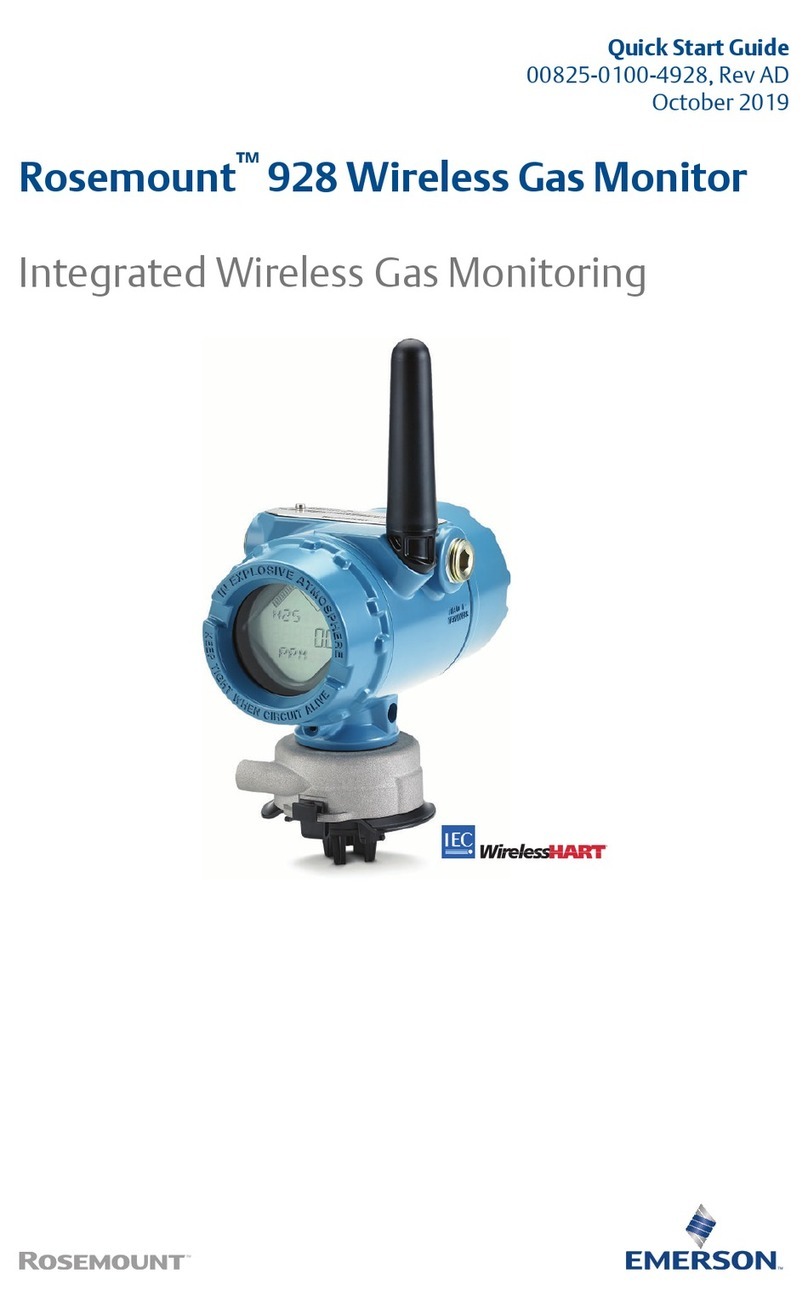
Emerson
Emerson Rosemount 928 quick start guide
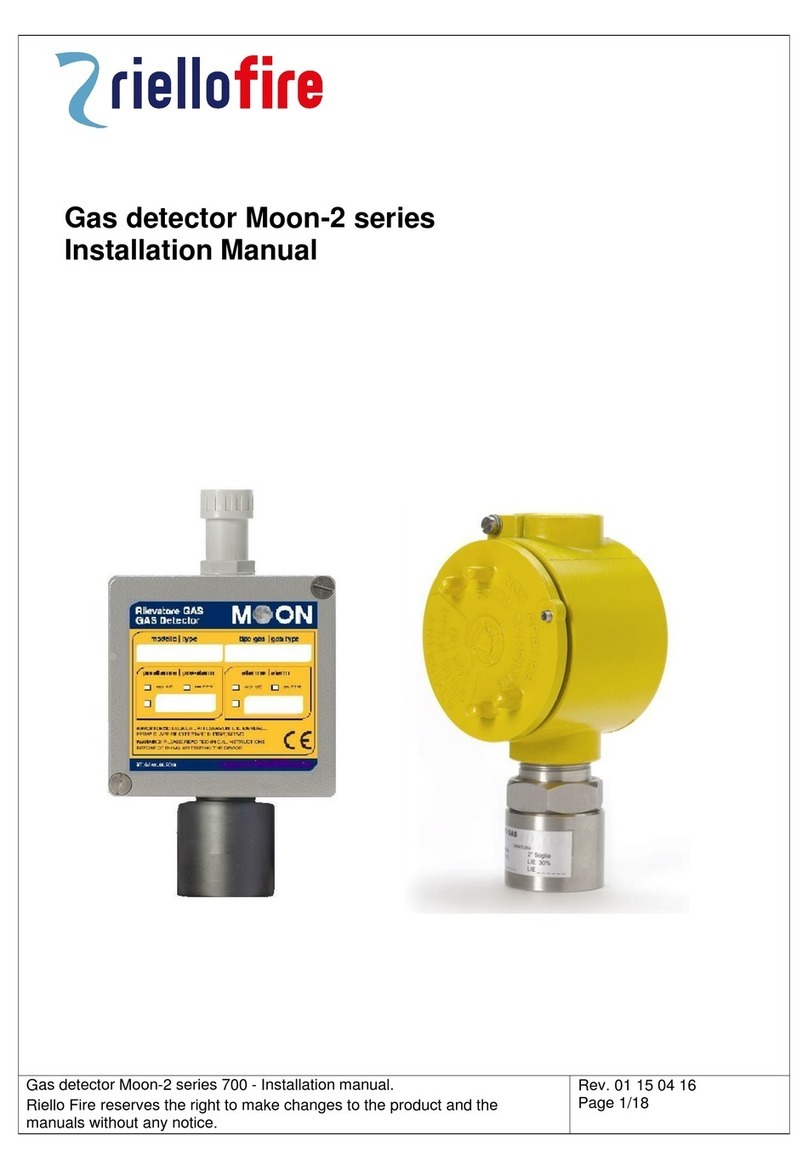
AVS Electronics
AVS Electronics riellofire Moon 2 Series installation manual
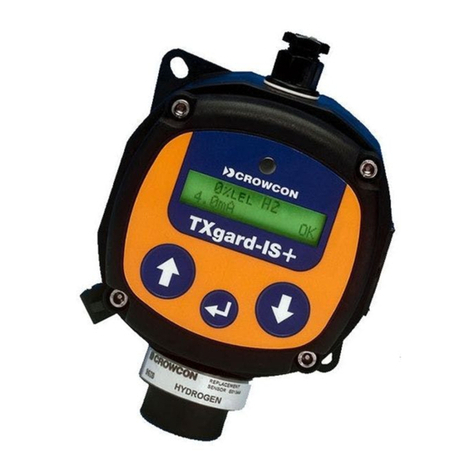
Crowcon
Crowcon TXgard-IS+ Installation, operation and maintenance instructions

SANJIANG
SANJIANG JTQ-BF-06TLLoRa user manual
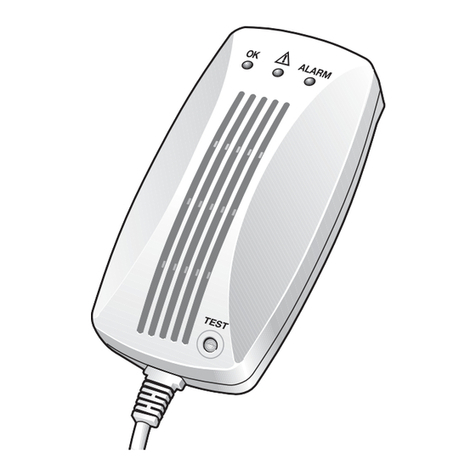
GEV
GEV FlammEx 003149 manual
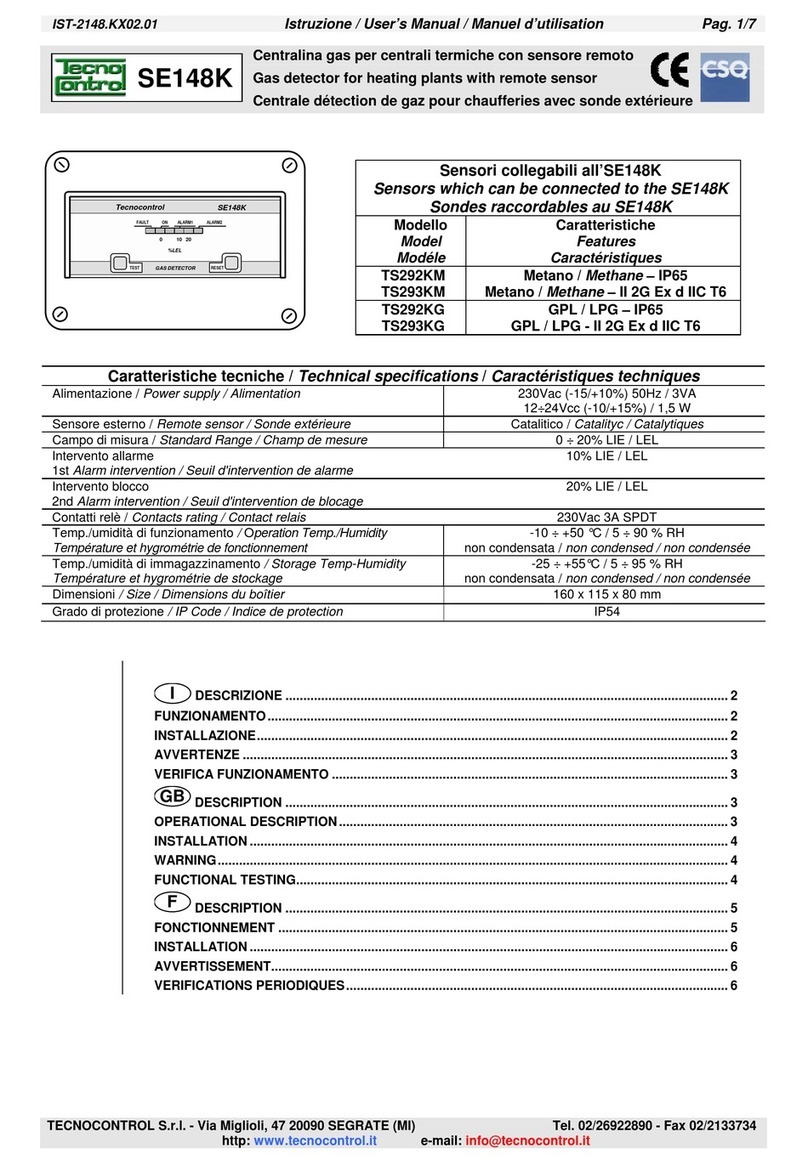
Techno Control
Techno Control SE148K user manual




